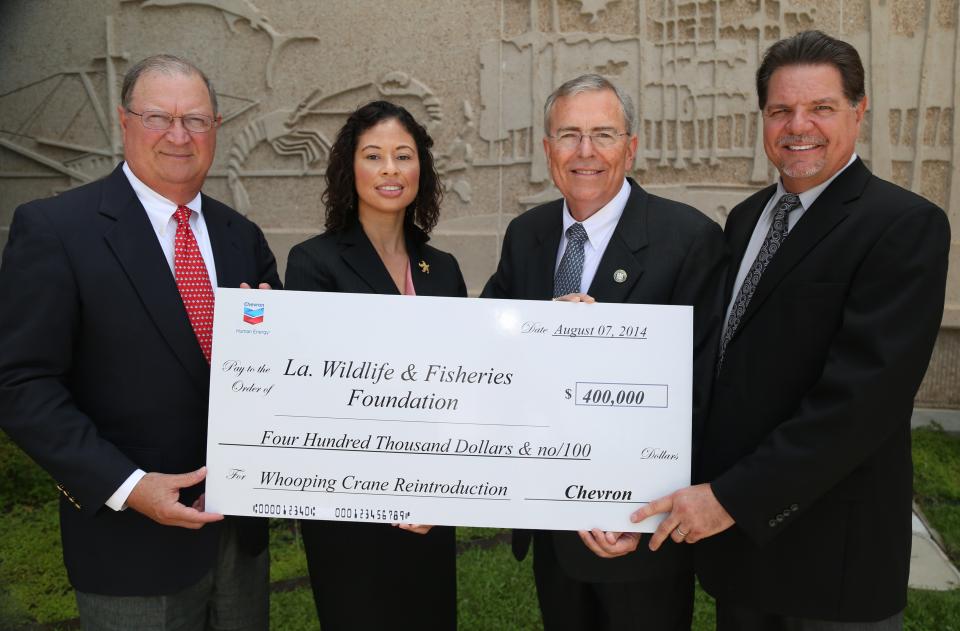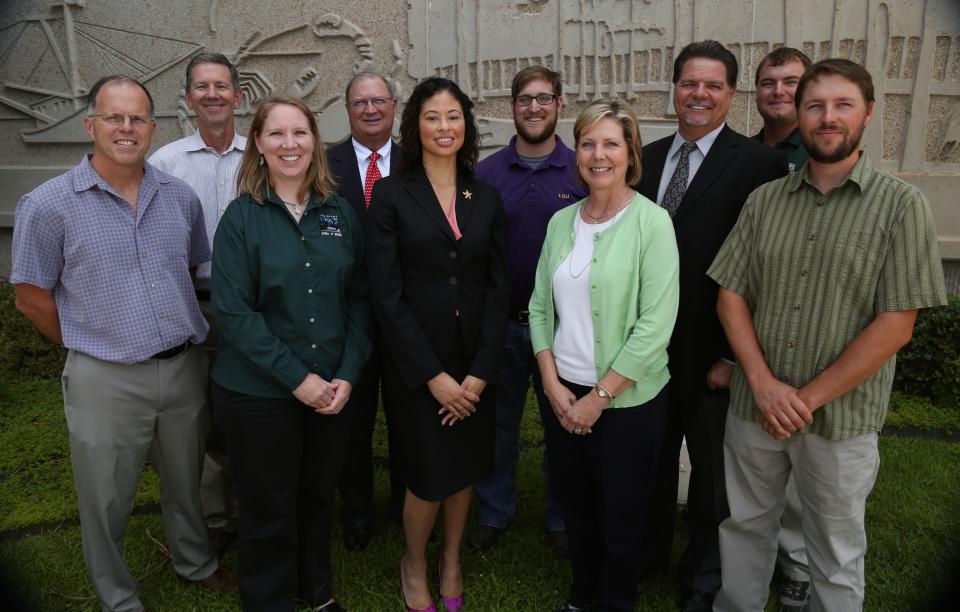

The Louisiana Department of Wildlife and Fisheries (LDWF) and Louisiana Wildlife and Fisheries Foundation (LWFF) recognized Chevron on Aug. 7 for three years of financial support provided for the department’s whooping crane reintroduction project which began in 2011.
In a ceremony at Thursday’s Louisiana Wildlife and Fisheries Commission meeting in Baton Rouge, commission members, department staff and meeting attendees were briefed on the value of the $400,000 in Chevron grant funding and all that it has provided from 2012 through 2014.
“Chevron chose to make a social investment in southwest Louisiana and this project presented an ideal opportunity,” said Robert Love, LDWF Coastal and Nongame Resources Division administrator. “Re-establishing the whooping crane within Louisiana’s ecosystem involves not only specialized research tools but a lot of people power and teamwork. Success and sustainability also requires raising public awareness and appreciation of the birds’ presence and educating our young citizens, as well as our farmers, on the importance having of this iconic and charismatic species back on the landscape. The Chevron grant funding was vital in each of these project components.”
“Chevron Gulf of Mexico recognizes the importance of protecting biological diversity – the rich variety of life on Earth, its ecosystems and species, and the ecological processes that support them,” said Sakari Morrison, Chevron Gulf of Mexico General Manager of Public Affairs. “For this reason, we are a proud and active partner in support of the Louisiana Wildlife and Fisheries Foundation and the Department and their work to reintroduce whooping cranes to Louisiana and educate the public on the importance of wildlife protection.”
The grant funding has provided for satellite transmitter equipment and associated communications costs for tracking the movement of the whooping cranes released from LDWF’s White Lake Wetland Conservation Area in Vermilion Parish. Biologists plot the birds’ movement, habitat selections and adaptive behavior as they adjust to life in the wild.
Supporting LDWF’s efforts, the LWFF has coordinated receipt and dispersal of grant funds for stewardship, public outreach and educational purposes. Kell McInnis, LWFF executive director, presented a signed print of the Chris Davis’ wildlife portrait “Taking Flight” to Morrison in appreciation of the corporate support provided for the project.
Grant funds have additionally been utilized for a public outreach media campaign designed to alert the public that the birds are now on the Louisiana landscape, they should be observed from a distance if spotted and LDWF should be notified if anyone witnesses cranes being harmed. Billboards have been produced, as well as television and radio announcements, to deliver these messages.
A third key component funded by the Chevron donation provides lesson plans and classroom tools that have been made available to Louisiana middle and high school teachers through educational workshops. Teachers then deliver endangered species information to students to foster an appreciation for non-game species and awareness of the significance of LDWF’s and its partners’ efforts.
The whooping crane, a very vulnerable species, was found in south Louisiana until their demise during the late 1800s and early 1900s when little conservation ethic was in existence and conversion of prairies and marsh lands to agriculture acreage became a trend. Since 2011, LDWF has soft released 50 isolation-reared, juvenile cranes provided by the US Geological Survey Research Center in Patuxent, Md., into rural southwest Louisiana, and 29 survive today. Nesting pairs within that experimental population have produced the first eggs in the wild in over 70 years, but no fledglings have resulted as yet.
The recovery plan goal is for Louisiana to reach a subpopulation of 25-30 productive pairs, which translates to about 130 cranes in Louisiana. This process could take 15 to 20 years. To learn more about Louisiana’s whooping crane population, go to http://www.wlf.louisiana.gov/wildlife/information . To contribute to the whooping crane project or any LDWF initiative, go to the LWFF website at http://lawff.org .
For more information, contact Bo Boehringer at 225-765-5115 or bboehringer@wlf.la.gov .
--------------------------------------------------------------------------------------------------------------------------------
*photo 1 – (left to right) La. Wildlife & Fisheries Foundation Executive Director Kell McInnis, Chevron Gulf of Mexico General Manager of Public Affairs Sakari Morrison, LDWF Secretary Robert Barham and LDWF Coastal and Nongame Division Administrator Bob Love gather after Aug. 7 LWF Commission meeting recognition for Chevron’s contributions to Louisiana’s whooping crane re-introduction project.
*photo 2 – LDWF’s whooping crane recovery team gather with Chevron’s Sakari Morrison (front row center) following Aug. 7 LWF Commission meeting. Team members (front row, left to right) Dr. Sammy King, USGS Cooperative Fish and Wildlife Research Unit at LSU Ag Center; Sara Zimorski, LDWF Project Biologist; Morrison; Venise Ortego, La. Environmental Education Commission Coordinator; Phillip Vasseur, LSU Ag Center Research Associate; (back row, left to right) Buddy Baker, LDWF Coastal and Nongame Division Biologist Director ; Kell McInnis, La. Wildlife & Fisheries Foundation Executive Director; Charles Smith, LSU Ag Center Research Associate; Bob Love, LDWF Coastal and Nongame Division Administrator; and Chad Gaspard, LDWF Technician.
